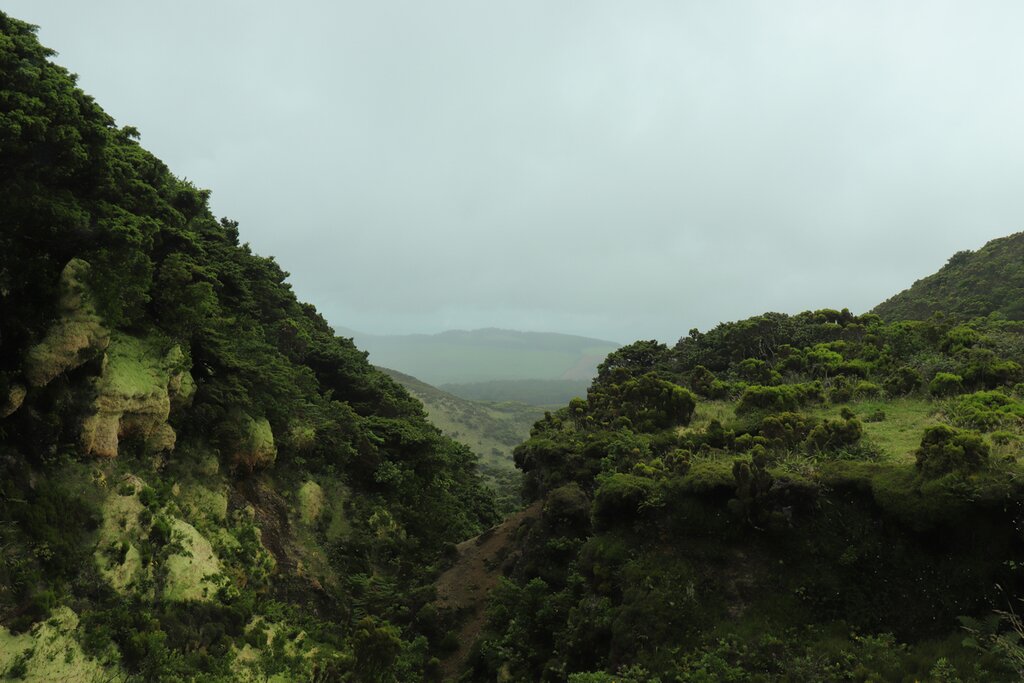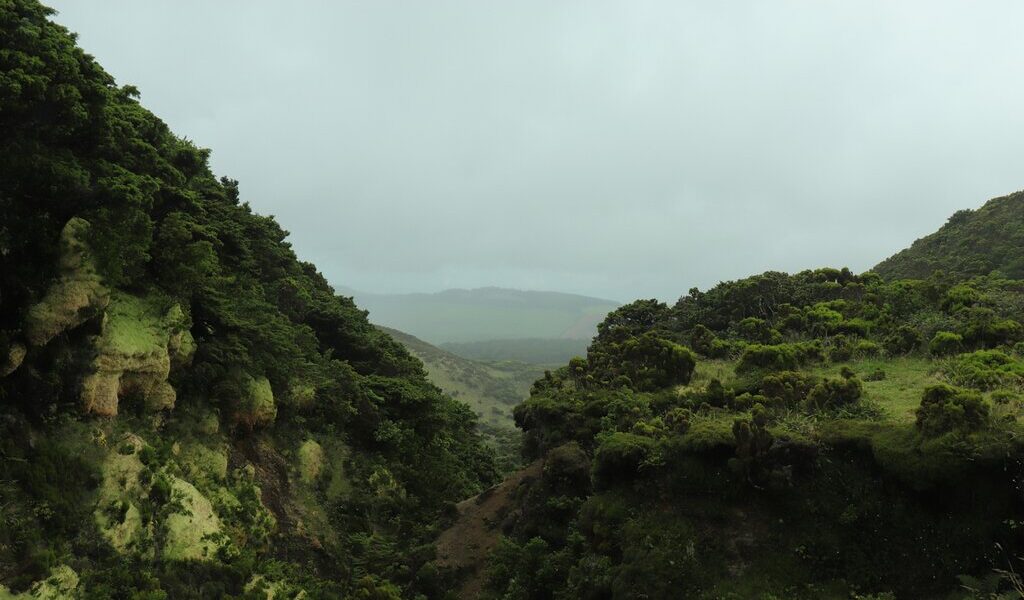
January is a great month to visit the Azores for nature enthusiasts and hearty adventurers. Towns and trails will be at their quietest, and once pricey accommodations can be yours for a fraction of the cost. Cooler temperatures are perfect for soaking in the picturesque hot springs on São Miguel and hiking Terceira’s lush trails.
## Weather in the Azores in January: A Detailed Overview
January in the Azores offers a unique travel experience, a world away from the bustling summer crowds. While it’s considered the second coldest month, with temperatures ranging from 54ºF (12ºC) overnight to a mild 63ºF (17ºC) during the day, the climate is far from frigid. Compared to many European destinations at this time of year, the Azores present a pleasant escape. However, potential visitors should be aware that January also falls within the wetter season, with an average of 16 to 19 days experiencing some form of precipitation. This equates to approximately 5.3 inches (135 mm) of rainfall throughout the month.
It’s important to note that the archipelago’s geography influences local weather patterns. The eastern islands, namely São Miguel and Santa Maria, generally experience drier conditions than their central and western counterparts, such as Flores and Corvo. This means that those planning to explore the eastern islands may encounter slightly sunnier spells. Regardless of which island you choose to visit, the ocean temperatures remain relatively consistent across the Azores, cooling down to around 61°F (16°C). While this might deter some from swimming, it’s still considerably warmer than the ocean temperatures found off the coasts of many mainland European countries during this period. This is in contrast to the peak of summer in August, when ocean temperatures reach a balmy (75ºF) 24ºC, providing a completely different experience for those who like to swim. Visitors should also prepare for moderate winds and the occasional thunderstorm, which can add an element of drama to the landscape. Packing layers and waterproof clothing is highly recommended to ensure comfort during your January visit.
## Exploring the Azores in January: Crowds and Costs
The Azores in January offer a welcome respite from the throngs of tourists that descend upon the islands during the peak summer months of July and August. The atmosphere is significantly quieter, attracting primarily hiking enthusiasts and seasoned off-season travelers seeking a more authentic and tranquil experience. One of the most appealing aspects of visiting the Azores in January is the dramatic reduction in accommodation prices. You can often find luxury hotel rooms, which command exorbitant rates during the summer, available for half their usual price or even less. This presents an excellent opportunity to indulge in a more upscale stay without breaking the bank.
While the reduced tourist traffic is a definite advantage, it’s worth noting that some businesses, particularly on the smaller islands of Flores and Corvo, may close down for the winter season. However, on the larger island of São Miguel, the local community remains vibrant, providing a lively atmosphere. You’ll find yourself surrounded by the comforting sounds of locals enjoying hearty, authentic stews in cozy restaurants as they wait out the occasional rain shower. Making reservations at restaurants is rarely necessary during this time of year, adding to the spontaneity of your dining experiences. However, if you’re planning to visit the renowned hot springs in Furnas, it’s highly advisable to book your spot in advance, as these popular attractions can still draw a crowd, especially during peak hours.
## Island Hopping in January: Where to Go in the Azores
The Azores archipelago comprises nine distinct islands, each offering its own unique charm and appeal. However, given the less frequent ferry services in January, it’s generally recommended to focus your exploration primarily on the two most populated islands: São Miguel and Terceira. This allows you to maximize your time and minimize potential travel disruptions.
Ponta Delgada, the capital city located on São Miguel, serves as an excellent base for your Azores adventure. The city boasts a wide array of accommodation options, allowing you to take full advantage of the lower prices. It also offers a diverse culinary scene, with numerous restaurants serving both traditional Azorean dishes and international cuisine. Additionally, Ponta Delgada is a hub for various guided tours and activities, including hiking excursions and dolphin-watching cruises.
Beyond Ponta Delgada, São Miguel offers a wealth of other attractions perfect for a winter visit. Sete Cidades, with its stunning volcanic crater lakes, is a must-see, offering breathtaking views and picturesque hiking trails. Furnas, famous for its geothermal activity, provides a unique experience, with the opportunity to soak in natural hot springs and sample the traditional Portuguese stew cooked underground using geothermal heat.
On Terceira, the cooler winter temperatures are ideal for exploring the charming streets of Angra do Heroísmo, a UNESCO World Heritage site. Admire the beautifully preserved Portuguese colonial-style buildings without having to contend with large crowds. From Angra do Heroísmo, you can easily access the volcanic chamber of Algar do Carvão, a truly awe-inspiring geological formation. For those seeking outdoor adventures, the numerous hiking trails at Furnas do Enxofre offer stunning views of the surrounding landscape.
## Activities and Experiences in the Azores in January: What to Do
January in the Azores presents a wonderful opportunity for outdoor activities, particularly hiking and indulging in the region’s natural hot springs. Furnas, situated on São Miguel, is a popular destination for both locals and visitors. It is home to Parque Terra Nostra, a botanical garden with a thermal pool, and Poca da Dona Beija, a series of smaller thermal pools perfect for a relaxing soak after a invigorating hike around Lagoa das Furnas.
Another unique hot spring experience on São Miguel is Ponta da Ferrari, a free thermal spring located directly in the ocean. The best time to visit Ponta da Ferrari is within two hours of low tide, when the thermal waters mix with the cooler ocean water, creating a truly unforgettable experience.
São Miguel boasts numerous other incredible hiking trails. Salto do Cabrito offers the unique experience of walking on a catwalk above a waterfall. The trails around Sete Cidades provide stunning views of the volcanic crater lakes and the surrounding landscape, culminating in the panoramic viewpoint of Pico da Cruz. For those seeking a more adventurous and less-traveled path, the Mistérios Negros Trail on Terceira Island offers a scenic trek across rolling green hills, leading to the summit of Pico do Gaspar.
While sunbathing might not be the most appealing activity in January, you can still enjoy the Azorean waters on a dolphin-watching excursion. The waters surrounding the Azores are home to a diverse range of marine life, including sperm whales and Risso’s, bottlenose, and common dolphins. Many tour companies offer guaranteed sightings or your money back. However, it’s important to be aware that tours can be canceled or postponed due to the variable weather conditions, so it’s best to book your tour early in your trip to allow for flexibility.
## Events in January: Cultural Highlights
MONTANHA Pico Festival, held on Pico Island between January 3 and January 31, is a month-long celebration of Portugal’s highest peak. This unique festival invites artists from around the world to submit films that explore mountain themes or are filmed in mountainous landscapes. The festival aims to raise awareness of the signs of overtourism on natural environments and to promote responsible tourism practices.
## Plan Your Azorean Adventure: Sample Itineraries
Discover the best of the Azores with these suggested itineraries:
Explore São Miguel’s stunning lakes, charming towns, and geothermal wonders while based in Ponta Delgada on this seven-day guided tour.
Venture on a self-drive adventure through São Miguel and Terceira, discovering São Miguel’s impressive geothermal activity and lush landscapes before transferring to Terceira to admire its colorful colonial architecture and unique lava formations.
The Azores in January offer a unique blend of natural beauty, cultural experiences, and peaceful tranquility. With careful planning and preparation, you can create an unforgettable travel experience in this enchanting archipelago.
B-2612

